Physical Address
304 North Cardinal St.
Dorchester Center, MA 02124
Physical Address
304 North Cardinal St.
Dorchester Center, MA 02124
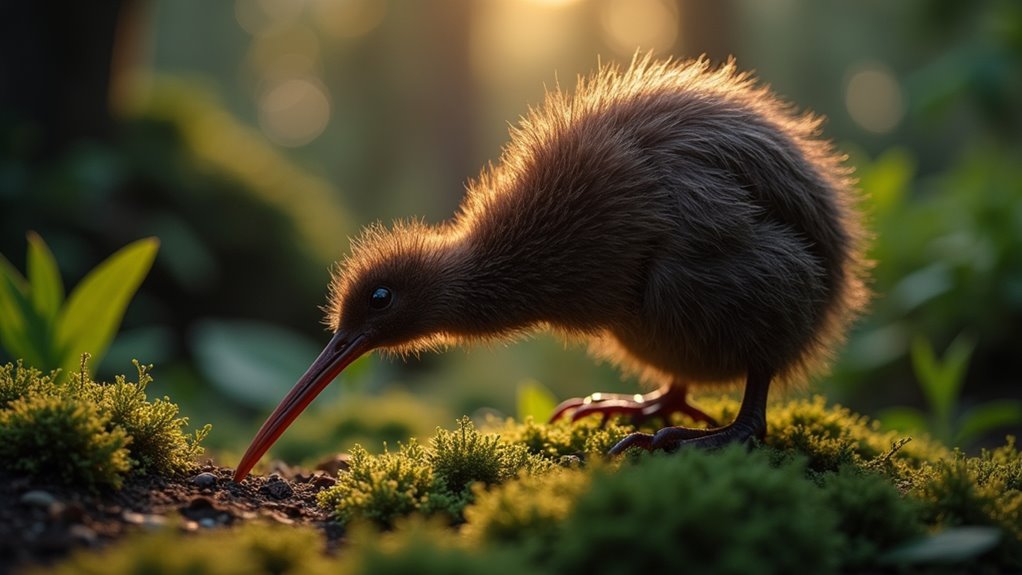
Kiwis laying massive eggs is just the start of New Zealand's wild animal kingdom that will leave you speechless.
New Zealand’s animals will astound you with their unique adaptations. The kiwi lays eggs weighing 25% of its body weight, while tuataras have a mysterious “third eye” on their heads. You’ll find giant carnivorous snails, the world’s heaviest insect (the wētā), and the takahē—rediscovered after being thought extinct for 50 years. The country’s isolated evolution created creatures found nowhere else, from the blue duck to the unusual huia bird. These remarkable creatures are just the beginning.

New Zealand’s incredible wildlife will leave you amazed, as this island nation boasts some of the world’s most unique animals found nowhere else on Earth. Did you know the kiwi bird is the only bird with nostrils at the tip of its beak, giving it an extraordinary sense of smell?
You’ll be surprised to learn that New Zealand’s only native land mammals are bats, which unusually spend time on the ground.
The country’s waters are home to Hector’s dolphin, the world’s smallest dolphin species. These rare marine mammals are easily identified by their distinctive round black dorsal fin and typically swim in small groups of 2 to 8 individuals.
New Zealand hosts over 100 endemic bird species and is considered the seabird capital of the world.
The island’s isolation has created an evolutionary haven where flightless birds thrived before humans and introduced predators arrived. Many visitors come specifically to observe native wildlife species that have evolved in isolation from mainland influences for millions of years.
When you think of living dinosaurs, the tuatara mightn’t immediately come to mind, but this remarkable reptile has earned its status as a true prehistoric survivor. This ancient creature is the sole remaining member of the Sphenodontia order that thrived 200 million years ago.
You’ll be fascinated by its “third eye” on top of its head—a light-sensing organ covered by scales in adults. Unlike most reptiles, tuataras prefer cooler temperatures and are active at night.
Males can reach 60cm in length, with females typically smaller at 40cm. Their distinctive spiny crest and unique tooth structure—two rows on top, one below—set them apart from lizards they superficially resemble.
Now found only on protected New Zealand islands, these living fossils remain virtually unchanged for 220 million years. With their impressive lifespan of 100 years, tuataras are among the longest-living reptiles on Earth. The name “tuatara” comes from the Māori language and means spiny back, reflecting their distinctive appearance.
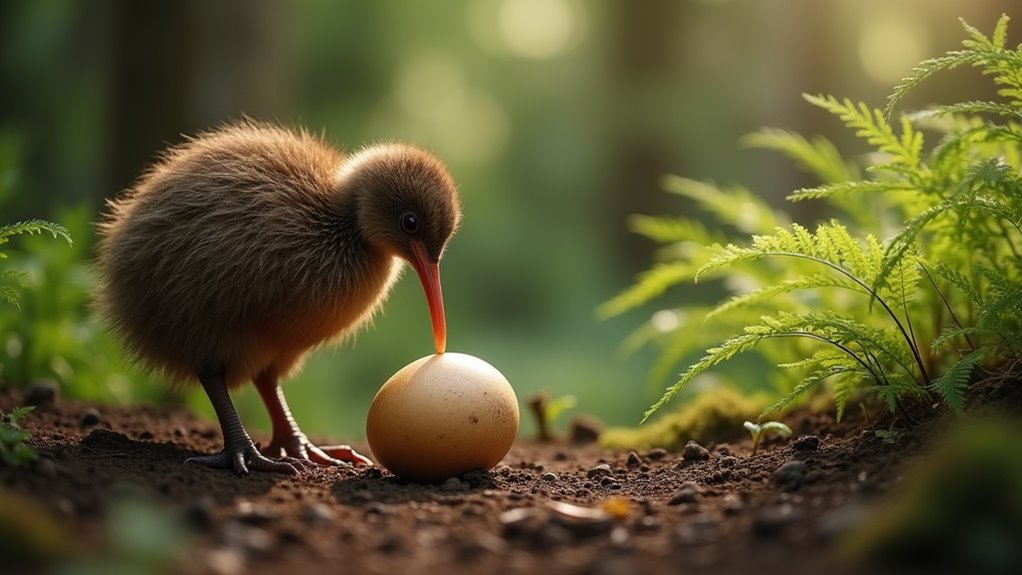
Among all birds worldwide, the kiwi is notable for its extraordinary reproductive feat—laying eggs that can weigh up to one-quarter of the female’s body weight. To put this in perspective, that’s six times larger than eggs from other birds of similar size, and far more extreme than an ostrich egg’s mere 2% maternal weight ratio.
The humble kiwi defies avian convention with eggs so massive they consume a quarter of the mother’s weight—nature’s ultimate pregnancy paradox.
When you’re expecting a kiwi egg, you’re truly eating for two—females must triple their food intake during the 30-day development period. Just before laying, they’ll fast for days as the massive egg takes up stomach space. These impressive eggs are now understood to have evolved as an adaptation for producing precocious chicks, rather than being remnants from larger ancestors as previously theorized.
This reproductive marathon causes females to lose 20% of their body weight. The kiwi’s remarkable reproductive system is just one of many reasons why Rotorua’s wildlife attracts nature enthusiasts from around the world.
Despite this tremendous physical cost, the investment pays off—kiwi chicks hatch remarkably well-developed, ready to face the world.
While kiwi birds make headlines for their enormous eggs, New Zealand harbors another size champion in the insect world. The giant wētā can weigh up up to 71 grams—heavier than a sparrow and three times as heavy as a mouse!
These prehistoric-looking creatures have survived since the dinosaur era but now face serious threats from introduced predators. You’ll find them primarily on predator-free offshore islands where they’ve developed their impressive size through island gigantism. Several giant wētā species have adapted to survive extreme alpine conditions, with some capable of remaining frozen solid at temperatures below -5°C. The conservation of these unique insects has become a priority at many of New Zealand’s must-visit attractions across the country.
Here’s what makes them remarkable:
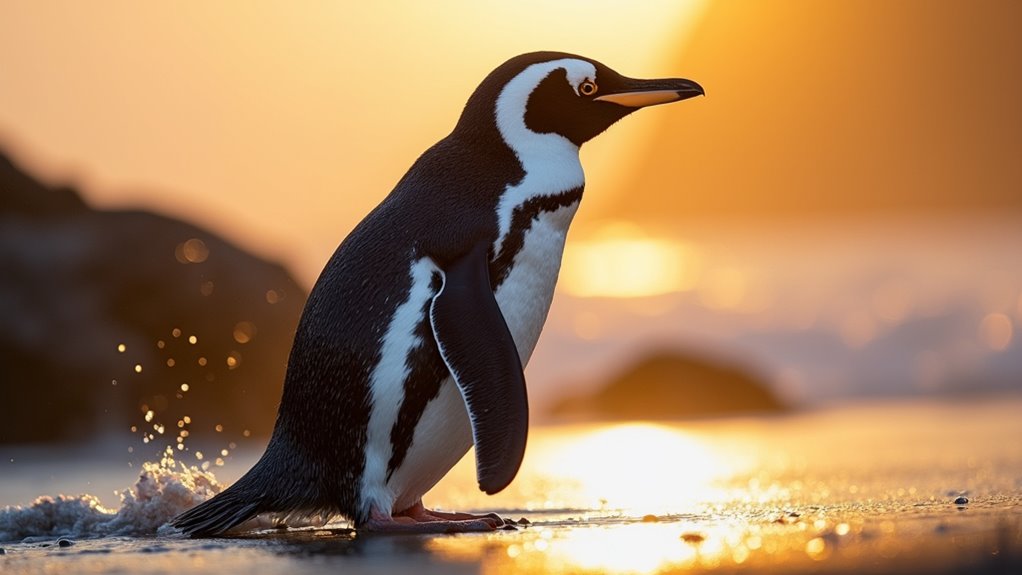
New Zealand’s yellow-eyed penguins (hoiho) are teetering on the brink of extinction, making them the rarest penguin species on Earth. Their population has plummeted by 76% since 1996, with only about 3,400 breeding individuals remaining.
You’ll find these ocean sentinels primarily on New Zealand’s South Island, where they face threats from all directions. On land, introduced predators like cats and dogs attack them. The hoiho are considered taonga species in traditional Māori culture, highlighting their cultural significance beyond ecological value. These remarkable birds serve as sensitive indicators of overall ocean health and environmental changes.
At sea, they struggle with starvation, disease, and fishing net entanglements.
Climate change further complicates their survival by altering ocean temperatures and food availability.
Conservation efforts include partnerships with the fishing industry, establishing protected areas, and tracking projects to monitor breeding success.
As indicators of marine ecosystem health, their decline signals broader environmental challenges that need urgent attention.
Measuring just 1.2 to 1.6 meters in length, Hector’s dolphins hold the distinction of being the world’s smallest marine dolphins. Endemic to New Zealand’s coastlines, these playful creatures are recognizable by their rounded dorsal fin and distinctive gray, black, and white coloration.
You’ll find these dolphins primarily around the South Island, where they hunt in shallow waters for small fish and squid. Their unique dorsal fin resembles Mickey Mouse’s ear, making them easily identifiable among other dolphin species.
With only about 15,000 remaining, they’re nationally vulnerable to extinction.
Here are four key threats they face:
New Zealand’s islands provide a unique sanctuary for these dolphins, as the country is one of the few places in the world with no land snakes in its ecosystem.
Conservation efforts include protected marine areas and fishing regulations to help these social, curious creatures survive.
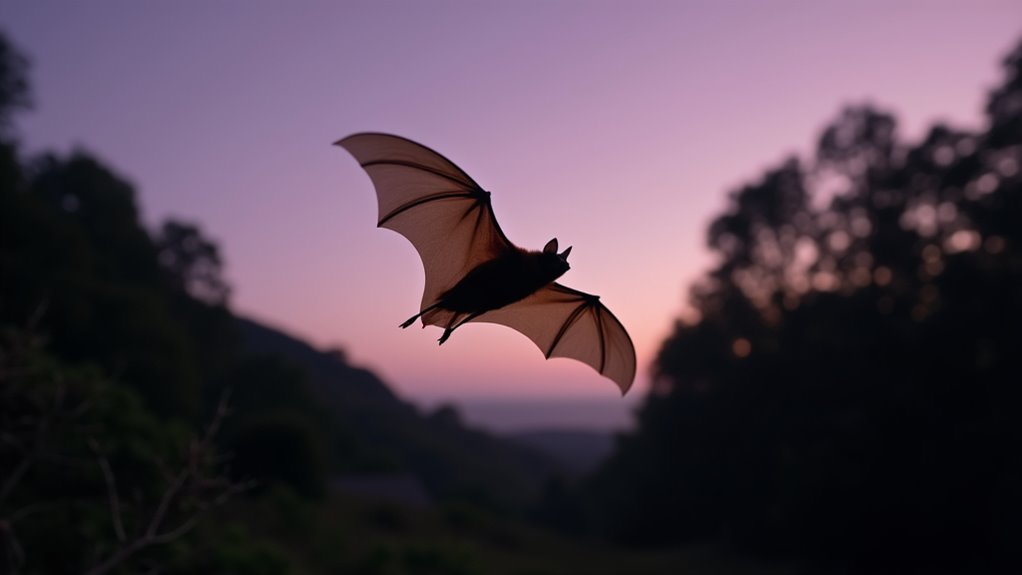
Unlike most landmasses on Earth, New Zealand developed without any native land mammals except for bats. Before humans arrived, you wouldn’t have found any native rats, cats, or other terrestrial mammals roaming the countryside.
New Zealand stands as an evolutionary island, where bats alone conquered the mammalian frontier before human arrival.
Only two bat species still survive today: the critically endangered long-tailed bat and the endangered lesser short-tailed bat. A third species, the greater short-tailed bat, hasn’t been seen since 1967 and is presumed extinct.
New Zealand’s bats have unique adaptations—the lesser short-tailed bat can actually crawl on the ground to forage, a rare trait among bats worldwide. These bats play a crucial ecological role as important pollinators for native plants, including the wood rose.
They’re now threatened by introduced predators like rats, stoats, and cats, which have dramatically altered New Zealand’s ecosystem. Conservation efforts focus on predator control and habitat restoration to save these remarkable flying mammals. The city of Rotorua’s forests provide crucial habitat for the long-tailed bat, making wildlife conservation a key reason to visit this unique region.
Among the many remarkable creatures found in New Zealand’s diverse ecosystem, sea lions stand out for their unusual inland excursions. Unlike other pinnipeds, these rare animals frequently venture away from coastal areas, traveling up to 2 miles inland—and in exceptional cases, even 60 km!
Why do they trek so far from the ocean? Here’s what makes their behavior unique:
These sea lions form unique mutualistic relationships with red-billed gulls, which remove parasitic insects from their backs while they rest during these inland adventures.
Their distinctive inland behavior makes New Zealand’s sea lions truly extraordinary among their kind, representing one of the great factors that make New Zealand an exceptional place for wildlife diversity.
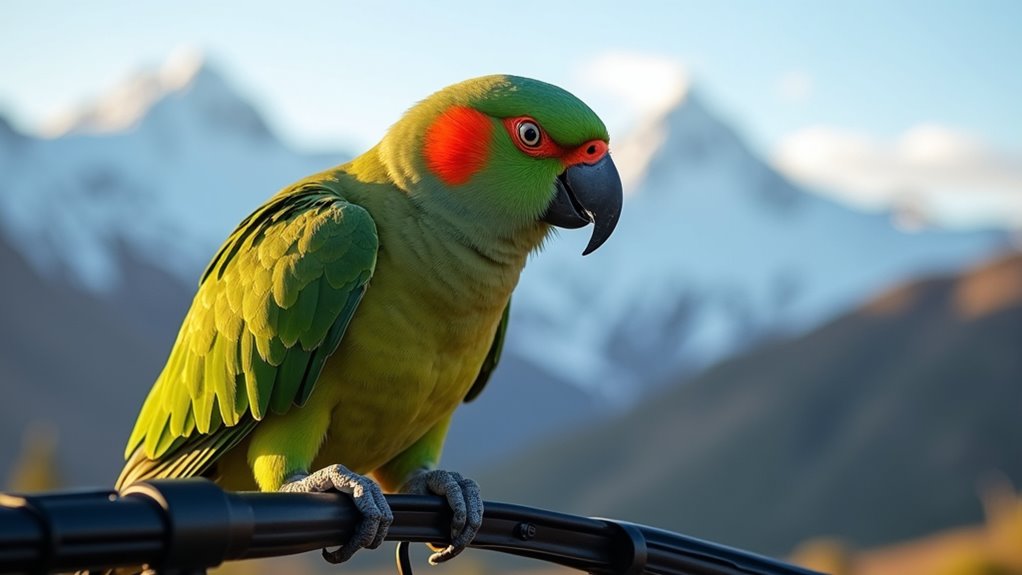
New Zealand’s mountains harbor one of the world’s most peculiar birds—the kea, the planet’s only true alpine parrot. These highly intelligent birds, known as the “clowns of the mountains,” have developed a bizarre reputation among locals and travelers alike.
You’ll find these endangered parrots fearlessly investigating your car, methodically dismantling rubber parts like windshield wipers and gaskets. Their mischievous behavior isn’t random—keas are among the smartest birds globally, solving complex puzzles with ease. With their distinctive keee-ahh call, these remarkable birds can be heard echoing across the Southern Alps.
They’ll also raid your campsite for unattended items, from food to equipment. While their antics may seem destructive, keas are simply exhibiting their natural curiosity and adaptability.
When you visit their mountainous habitat, secure your belongings—these clever birds in their “circus” or “curiosity” groups won’t hesitate to dismantle your possessions. Unlike New Zealand’s diverse common spiders, keas are highly visible and interactive, making them memorable encounters for visitors to the country’s alpine regions.
Despite being home to countless unique species, New Zealand remains remarkably snake-free—a fact that’s both surprising and significant in the natural world. This snake absence is no accident but rather the result of geographic isolation and evolutionary history.
The snake-free ecosystem has several interesting implications:
In stark contrast to nearby Australia, where deadly spiders pose significant risks to humans, New Zealand offers a relatively safer environment for wildlife enthusiasts.
This snake absence has helped shape the country’s distinctive biodiversity and protected its unique endemic species. Instead of snakes, visitors may encounter the tuatara, a distinctive reptile that exists nowhere else on Earth.
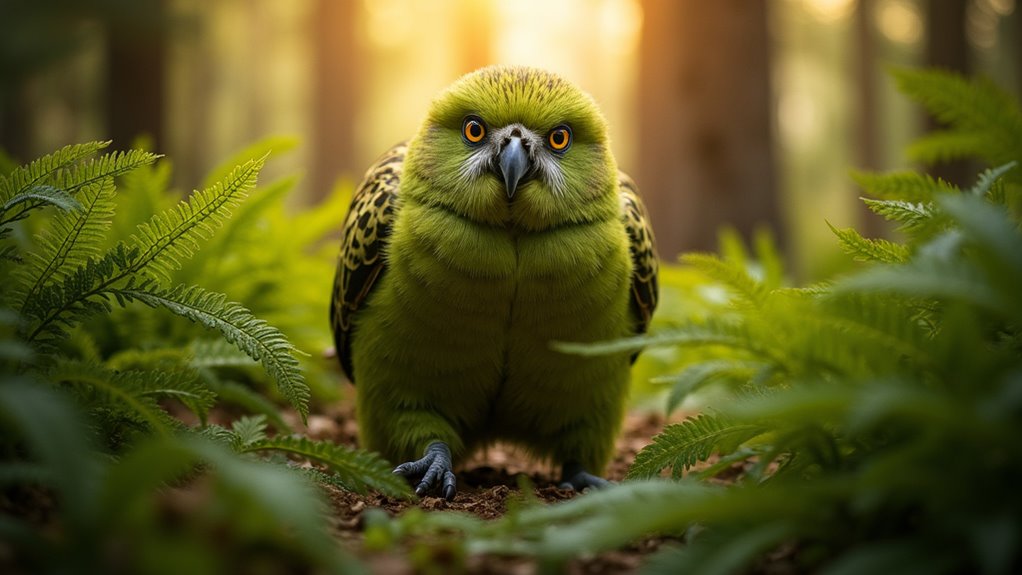
Why has the kakapo captured the imagination of conservationists worldwide? This moss-green giant is utterly unique—the world’s only flightless parrot, weighing up to 5 pounds with an owl-like face and exceptional longevity of 58-90 years.
You’ll never spot one during daylight; these nocturnal herbivores prefer solitude, coming together only for their fascinating lek breeding system where males boom deeply to attract females. These distinctive calls can travel several kilometers as males produce low-frequency booms for up to 8 hours each night during breeding season.
Their population teetered at just 50 birds in the mid-1990s, showcasing how vulnerable flightless birds are to introduced predators.
Thanks to intensive conservation efforts, their numbers have climbed to 149 as of 2018.
They’re now managed exclusively on predator-free islands—a remarkable turnaround for a species that was once New Zealand’s third most common bird. Unlike the coastal cities of eastern Australia, New Zealand’s isolated geography has created the perfect evolutionary conditions for unique species like the kakapo to develop.
While the kakapo amazes with its flightless nature, another New Zealand resident boasts an equally extraordinary feature that sounds like science fiction. The tuatara, often called a “living fossil,” possesses a genuine third eye on top of its head, complete with a lens, retina, and photoreceptors.
This remarkable third eye:
The third eye doesn’t provide detailed vision but likely helps these burrowing reptiles monitor light levels, supporting their survival in New Zealand’s unique ecosystem. Understanding these unique adaptations gives insight into how wildlife has evolved to thrive despite New Zealand’s high cost of living compared to many other countries. As the tuatara ages, this special sensory organ becomes covered by scales at around 4-6 months, making it more visible in juvenile specimens.
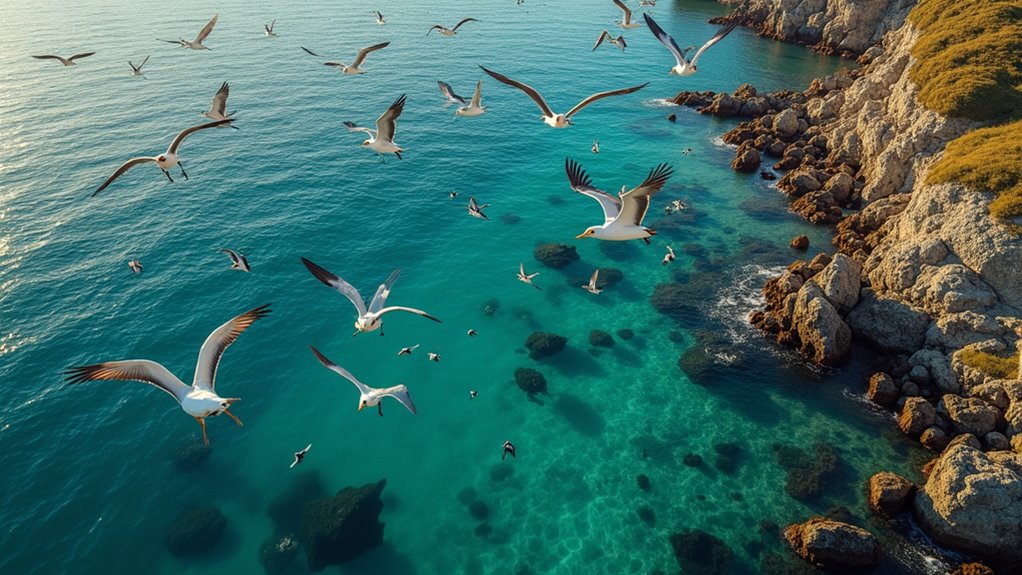
When you consider New Zealand’s vast marine territories, it’s not surprising that this island nation serves as a global sanctuary for seabirds. The subantarctic islands are recognized worldwide as seabird diversity hotspots, with approximately 84 species breeding in the region and 38 endemic to New Zealand.
You’ll find more penguin species here than anywhere else on Earth, alongside majestic albatrosses—the world’s largest flying seabirds.
Unfortunately, 90% of these remarkable creatures face extinction threats from predators, habitat loss, climate change, and fishing bycatch. Similarly concerning, about 82% of shorebirds are also threatened or at risk.
Conservation efforts include establishing protected sanctuaries, implementing predator control programs, and using advanced tracking technology to monitor migrations. While Australia offers sailing adventures along its coastlines where many seabirds can be spotted, New Zealand provides unique wildlife viewing opportunities not found elsewhere. These initiatives are vital, as many endemic species like the Westland petrel and Whenua Hou diving petrel breed exclusively on remote New Zealand islands, requiring specific protection measures.
How would you picture a duck that makes its home not in peaceful ponds, but in turbulent mountain rapids? Meet the blue duck (whio), a remarkable New Zealand native perfectly adapted for life in fast-flowing mountain rivers.
These endangered birds are true river specialists with:
Specialized for wild rapids where other ducks dare not venture, these remarkable blue-grey birds are nature’s true river masters.
You’ll only find these unique ducks in New Zealand’s mountains, where they’ve evolved to thrive in conditions that would challenge any ordinary waterfowl. While exploring New Zealand, many visitors enjoy food culture tours that combine wildlife spotting with sampling local cuisine. With fewer than 1000 breeding pairs remaining as of 2011, conservation efforts through predator trapping programs have become essential for their survival.
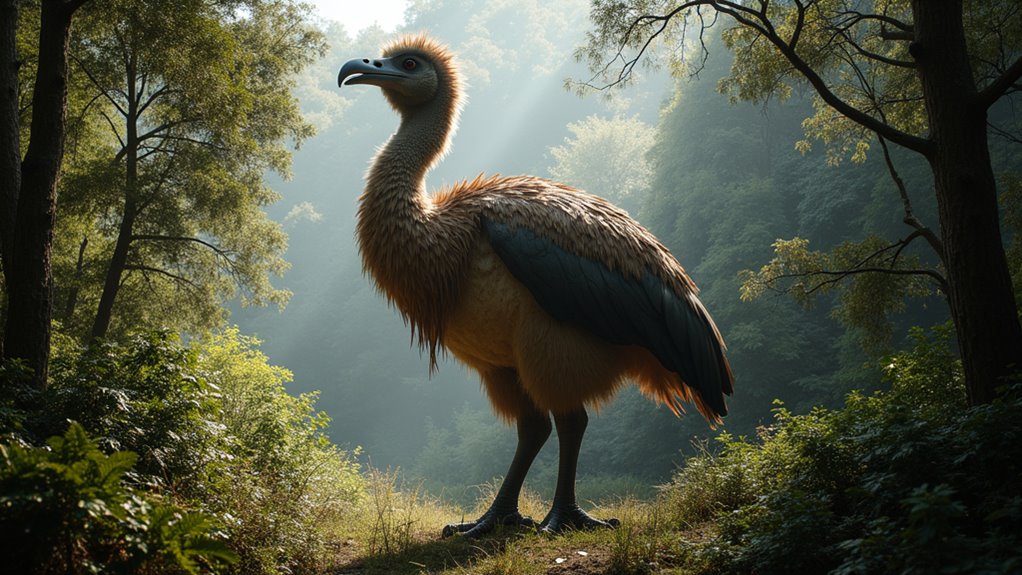
Nine species of colossal, flightless birds once dominated New Zealand’s landscape before humans arrived—the prehistoric moa. The largest species towered at an impressive 3.7 meters (12 feet) tall and weighed up to 250 kg (550 pounds).
Unlike any other birds on Earth, moas had absolutely no wings—not even vestigial ones. These herbivores used over 3 kg of stones in their gizzards to grind tough plant material. They laid enormous eggs measuring up to 25 cm long.
When Polynesians arrived in New Zealand, approximately 58,000 moas roamed from shrublands to subalpine regions. Moas had a remarkable evolutionary history, existing for approximately 17 million years before their extinction. Sadly, overhunting led to their extinction by the late 17th century—300 years before Europeans arrived.
The Māori described them as swift runners that would kick defensively when cornered. Visitors to New Zealand today should respect the country’s unique wildlife heritage by following conservation guidelines to prevent similar extinctions.
While the extinct moa couldn’t fly, other remarkable New Zealand natives excel in completely different environments. New Zealand fur seals are oceanic masters who can hold their breath for an impressive 11 minutes while diving to depths over 200 meters.
These incredible marine mammals have evolved specialized adaptations that allow them to thrive in coastal waters:
These physiological specializations help fur seals forage effectively for fish, squid, and crustaceans while avoiding predators in their underwater world. For those visiting Queenstown’s coastline, these fascinating creatures can sometimes be spotted playing in the waters during certain times of the year.
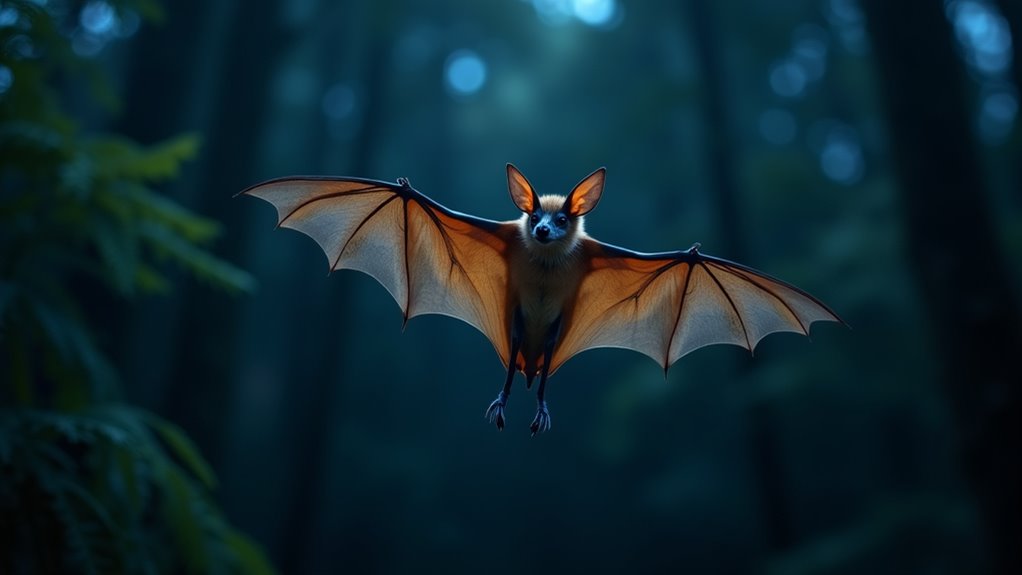
Have you ever wondered what makes New Zealand’s long-tailed bats so special? These remarkable creatures navigate and hunt using echolocation that’s completely inaudible to your ears. They produce high-frequency sounds above 20 kHz—beyond the upper limit of human hearing.
The silent symphony of New Zealand’s long-tailed bats plays nightly, their ultrasonic calls crafting a world beyond human perception.
When flying, these bats emit ultrasound clicks with a peak amplitude around 28 kHz and lasting about 6.3 milliseconds. These sounds bounce off objects and return as echoes, creating a detailed “sound map” of their surroundings.
You’ll find these bats often foraging at forest edges where their echolocation works most effectively. The forest floor’s clutter would interfere with their sound signals, making aerial hunting their preferred strategy.
This remarkable adaptation is why they’re such successful nocturnal predators despite being completely silent to us.
While Australia has its own unique wildlife, New Zealand’s bats represent the country’s only native land mammals, making them particularly special to the island nation’s ecosystem.
When you picture true love in the animal kingdom, Fiordland crested penguins offer a remarkable example of long-term partnerships. These New Zealand natives practice what scientists call “serial monogamy”—they’re not literally mated for life, but they do show impressive fidelity.
These tawaki penguins demonstrate remarkable loyalty in four fascinating ways:
You’ll find these devoted couples performing synchronized courtship displays during their July-November breeding season.
If you’re planning an Australian adventure, both Sydney and Melbourne offer opportunities to learn about unique wildlife conservation efforts in the region.
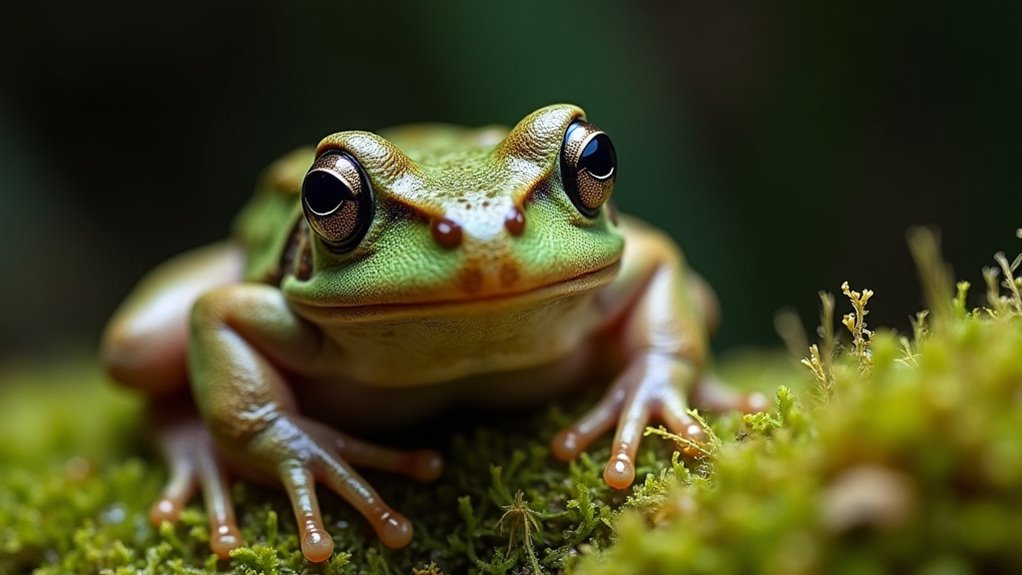
If you’re looking for an incredibly rare amphibian, the Hamilton’s frog deserves your attention as one of the scarcest creatures on Earth. Originally confined to just Stephens Island in New Zealand’s Marlborough Sounds, conservation efforts have expanded their habitat to include Maud Island and several predator-free sanctuaries.
These nocturnal frogs emerge at night when humidity levels are favorable, retreating to rock piles or dense vegetation by dawn. You’ll find they’re homebodies, rarely venturing more than 5 meters from their hiding spots. They live at elevations around 300 meters above sea level.
Fossil records reveal they once inhabited much wider territories across New Zealand’s North Island before their range dramatically contracted. Despite their endangered status, successful translocations are slowly helping their populations recover. While exploring Dunedin worth visiting regions, remember that these frogs represent just one of New Zealand’s many fascinating endangered species requiring conservation attention.
While the Hamilton’s frog represents New Zealand’s rarity in the amphibian world, the country’s waters host another remarkable creature that holds its own world record. The Little Blue Penguin (Eudyptula minor) stands at just 25-35cm tall and weighs barely over 1kg, making it the world’s smallest penguin species.
These adorable birds, also called Fairy Penguins, have some fascinating characteristics:
You’ll find these tiny penguins throughout New Zealand and southern Australian coasts. For those looking to see these charming creatures regularly, some of New Zealand’s affordable coastal areas offer excellent opportunities to observe Little Blue Penguins in their natural habitat.
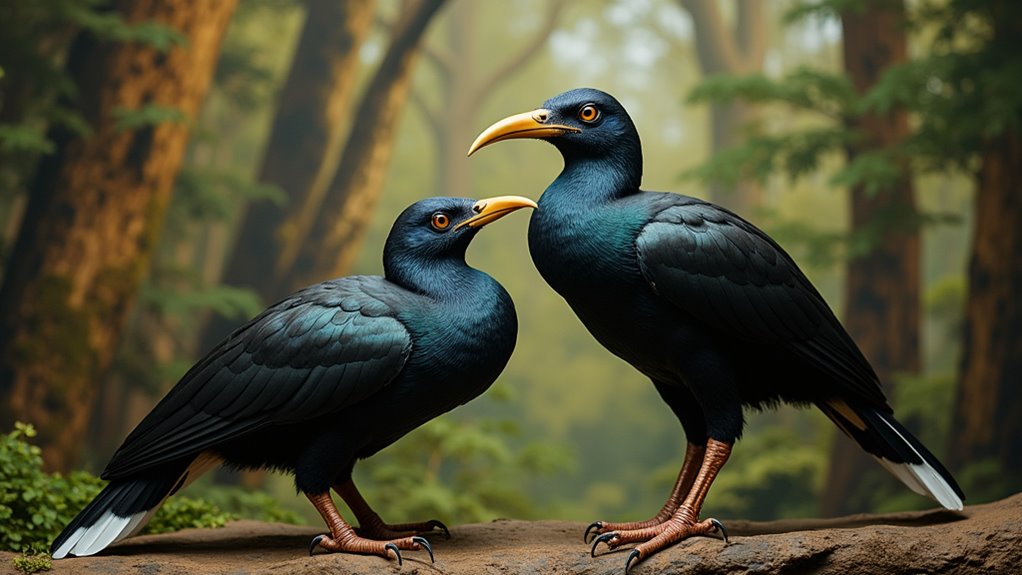
Among New Zealand’s extraordinary extinct bird species, the huia is notable for its remarkable sexual dimorphism in beak shape—a feature unparalleled in the bird world.
You might be surprised to learn that females possessed curved beaks measuring around 104 mm, while males had shorter 60 mm straight beaks. This wasn’t just for show—these differences served practical purposes.
Females used their long, curved bills to probe deep into tree cavities for insects, while males chiseled into rotted wood with their stronger beaks.
This complementary feeding strategy allowed huia pairs to exploit different food sources without competition.
Scientists initially misidentified males and females as separate species due to this extreme difference.
Sadly, the huia became extinct around 1907, leaving its unique ecological niche empty.
New Zealand’s Black Robin represents what many conservation experts consider the most dramatic rescue from extinction in modern history. By 1980, only five birds remained, including just one fertile female named “Old Blue”—the matriarch of all living Black Robins today.
The Black Robin’s journey from just five birds to survival stands as conservation’s greatest comeback story.
Wildlife conservationist Don Merton led an innovative rescue operation that included:
Today, the population has rebounded to around 300 birds, and their conservation status has improved from Endangered to Vulnerable—proving that even the most desperate conservation situations can be reversed with ingenuity.
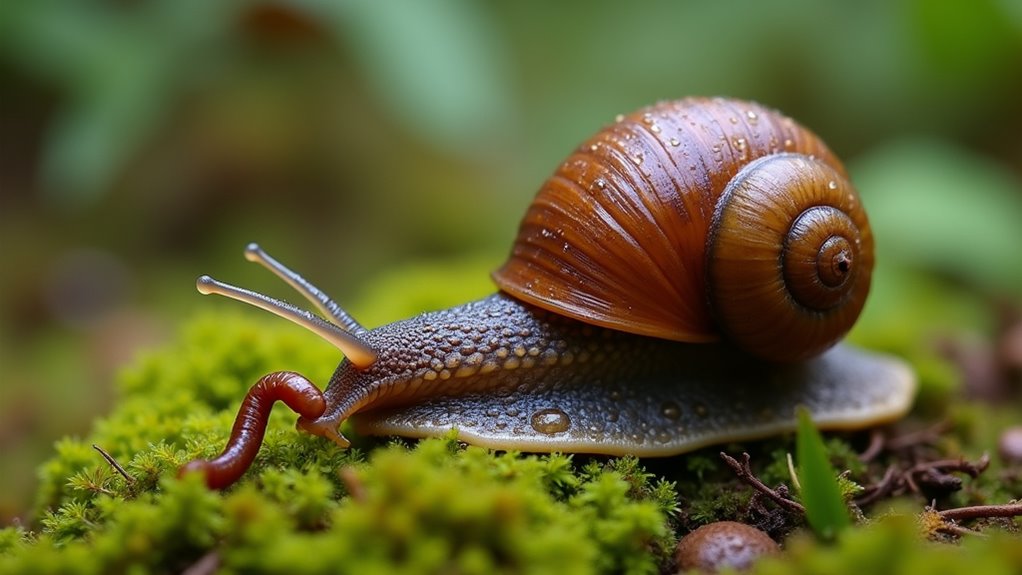
Unlike their vegetarian cousins worldwide, these predatory snails hunt earthworms and slugs, sucking them up like spaghetti with thousands of teeth designed for shredding prey.
You’ll find them throughout New Zealand, particularly in locations like Kahurangi National Park and parts of the South Island.
With shells displaying vibrant colors from red to black, they’re as beautiful as they’re unusual.
Sadly, they’re facing serious threats – climate change, exotic predators, and habitat loss have pushed 43 species to “Nationally Critical” status.
Despite these challenges, these extraordinary hunters can live for at least 20 years in the wild.
The takahē stands as one of conservation’s most remarkable comeback stories. This flightless blue-purple bird vanished from scientific records after 1898, only to be dramatically rediscovered in 1948 by Dr. Geoffrey Orbell in New Zealand’s remote Murchison Mountains.
Here’s what makes the takahē’s story so extraordinary:
Today, the takahē serves as a flagship species for New Zealand’s conservation efforts, symbolizing hope for other endangered species recovery programs worldwide.

Among the world’s most unusual carnivores, Powelliphanta snails lurk in New Zealand’s forests as skilled earthworm hunters. Despite their slow reputation, these hefty predators can grow to 3.6 inches long and possess lightning-fast reflexes when capturing prey.
Don’t be fooled by their shells—these carnivorous giants strike with surprising speed when dinner comes crawling.
You might be surprised to learn they’re equipped with thousands of tiny “teeth” on their radula, which they use to efficiently scrape apart earthworms, slugs, and even other snails.
At night, they emerge to stealthily approach their prey, consuming earthworms with a technique that resembles slurping spaghetti.
Unfortunately, several Powelliphanta species face extinction due to habitat loss from mining activities. Conservation efforts include relocating populations, captive breeding programs, and DNA analysis to better comprehend their dietary needs and ensure these remarkable carnivorous snails survive for generations to come.
You’ve journeyed through New Zealand’s living museum, where each creature tells a story of evolution’s remarkable path. From the ancient tuatara to the resilient black robin, these animals aren’t just wildlife—they’re symbols of nature’s resilience and wonder. When you think of New Zealand now, don’t just picture stunning landscapes; remember it’s home to some of Earth’s most extraordinary evolutionary experiments. They’re waiting, should you ever venture to this biological treasure island.